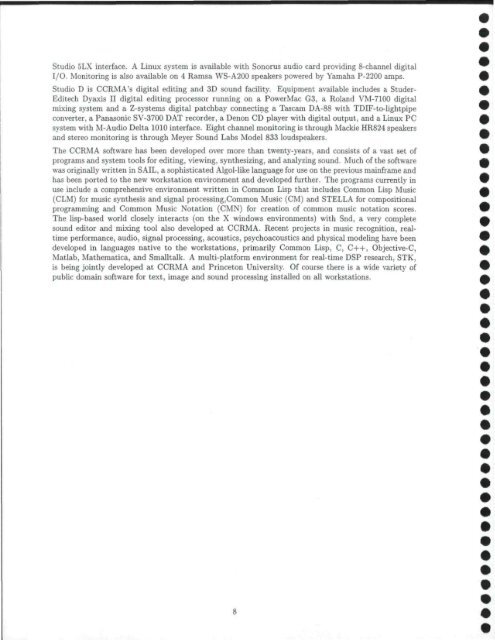CCRMA OVERVIEW - CCRMA - Stanford University
CCRMA OVERVIEW - CCRMA - Stanford University
CCRMA OVERVIEW - CCRMA - Stanford University
Create successful ePaper yourself
Turn your PDF publications into a flip-book with our unique Google optimized e-Paper software.
Studio 5LX interface. A Linux system is available with Sonorus audio card providing 8-channel digital<br />
I/O. Monitoring is also available on 4 Ramsa WS-A200 speakers powered by Yamaha P-2200 amps.<br />
Studio D is <strong>CCRMA</strong>'s digital editing and 3D sound facility. Equipment available includes a Studer-<br />
Editech Dyaxis II digital editing processor running on a PowerMac G3, a Roland VM-7100 digital<br />
mixing system and a Z-systems digital patchbay connecting a Tascam DA-88 with TDIF-to-lightpipe<br />
converter, a Panasonic SV-3700 DAT recorder, a Denon CD player with digital output, and a Linux PC<br />
system with M-Audio Delta 1010 interface. Eight channel monitoring is through Mackie HR824 speakers<br />
and stereo monitoring is through Meyer Sound Labs Model 833 loudspeakers.<br />
The <strong>CCRMA</strong> software has been developed over more than twenty-years, and consists of a vast set of<br />
programs and system tools for editing, viewing, synthesizing, and analyzing sound. Much of the software<br />
was originally written in SAIL, a sophisticated Algol-like language for use on the previous mainframe and<br />
has been ported to the new workstation environment and developed further. The programs currently in<br />
use include a comprehensive environment written in Common Lisp that includes Common Lisp Music<br />
(CLM) for music synthesis and signal processing,Common Music (CM) and STELLA for compositional<br />
programming and Common Music Notation (CMN) for creation of common music notation scores.<br />
The lisp-based world closely interacts (on the X windows environments) with Snd, a very complete<br />
sound editor and mixing tool also developed at <strong>CCRMA</strong>. Recent projects in music recognition, realtime<br />
performance, audio, signal processing, acoustics, psychoacoustics and physical modeling have been<br />
developed in languages native to the workstations, primarily Common Lisp, C, C++, Objective-C,<br />
Matlab, Mathematica, and Smalltalk. A multi-platform environment for real-time DSP research, STK,<br />
is being jointly developed at <strong>CCRMA</strong> and Princeton <strong>University</strong>. Of course there is a wide variety of<br />
public domain software for text, image and sound processing installed on all workstations.<br />
8

















